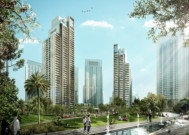
Incentivising sales and rentals seems to have become a more prominent feature this year, coinciding with a sentiment that buyers and tenants have less money to spend. Incentives have been around for a while, and during Ramadan developers often offer something extra. Nshama, for example, announced a payment scheme for some of its Town Square properties wherein customers will pay 80 per cent on handover, while Dubai Properties is waiving half of the transfer fee on some projects.
“These tactics will help to differentiate between different projects when buyers are thinking about off-plan,” says Mario Volpi, chief sales officer of Kensington Exclusive Properties. However, he points out that primary or off-plan buyers don’t base their decisions solely on freebies, but also consider other factors such as the developer’s track record, location, build quality, facilities and price.
Developers, therefore, need to offer a unique product, attractive pricing or customer-friendly payment plan. Also, they have to pay a good commission to agents, who are crucial in getting new buyers.
“A vanilla project at a vanilla price will simply not stand out anymore with that much stock around,” says John Stevens, managing director of Asteco. “People have plenty of choice. Developers who can self-finance their projects can offer post-handover payment plans, others will resort to creating different kinds of offers.” Although there are concerns about the present economic situation, Stevens says the long-term outlook remains generally positive.
“We have to take each month as it comes. The economy may be still quite fragile, and some sectors may have let people go,” says Stevens. “Anecdotally we hear people are leaving or sending families home, but at the same time new businesses, such as start-ups, are being created.”
Richard Paul, head of valuation at Cluttons, says incentives are par for the course if developers want to sell, but he insists the market remains active. “As the economy globally improves, people will start to become more robust in their decision making, and employment offers will rise,” says Paul. “It’s a patience thing, but it’s not that nothing is happening. It’s still busy.”
Paul says he was able to monitor around 100 villas in the secondary or ready property market change hands monthly between November and April this year, and about the same amount being snapped up in the off-plan market.
“Now that may not be that many, if you consider all the new projects, but it is quite remarkable that the off-plan market is performing at an equivalent level,” he says. “People are predicting a trough in the market now, and seeing 2017, possibly 2018, as a time we will look back to and say ‘that was a good time to buy’.”
Sentiment in numbers
Figures from Reidin demonstrate enthusiasm for newly launched off-plan property, in particular in Dubai Creek Harbour and Dubai South, The Pulse and Urbana South, as well as in Downtown Dubai.
“We have observed an increase in both secondary and off-plan market transactions in the first quarter, when compared with the same term last year,” says Ozan Demir, data and research manager of Reidin. “In the off-plan segment, residential off-plan sales transactions show that there has been a 100 per cent increase in sales between the first quarter of 2017 and last year.”
The figures also reveal that investors are looking for mid-market properties and are buying more properties worth at least Dh1 million this year compared with the previous year.
“This increase in year-on-year activity, coinciding with the increase in completed transactions, attests to the overall continuing improvement in sentiment that has been under way for a few months now,” says Demir.
Communities that have seen increased transactions are The Springs and Meadows, followed by Dubai Sports City and the Palm Jumeirah. The report also noted activity in The Greens, Jumeirah Lakes Towers (JLT), IMPZ and Dubai Marina. However, Reidin saw no movement in Arabian Ranches during the same period, while International City saw a fall in transactions.
Moreover, while prices in Arabian Ranches remained largely stable, prices in International City and Palm Jumeirah fell. On the other hand, the Springs, Meadows and Dubai Marina have been experiencing price increase of between 2 per cent and 6 per cent.
“In the first quarter, even though the total numbers in the secondary market are subdued by 50 per cent compared to its peak in the first quarter of 2014, there has been an uptick of 25 per cent in the transactional activity, when compared to the same term in 2016,” says Demir. “This can be explained by reduced property prices attracting investors and we call it a new value discovery.”
Favoured property
The secondary market seems to face stiffer competition from off-plan properties that are close to completion, despite the known drawbacks of off-plan, such as lack of amenities. Paul says this can be attributed to buyers believing that new projects will ultimately be better than existing ones.
“The mindset is that new is best,” says Paul. “[Unlike buying a car wherein you wouldn’t mind] your new car’s value dropping by 10 per cent the moment you drive it, property can’t be treated like that. You have to maintain [its value] and invest in it. With off-plan you’re taking a risk. You don’t know if it’s working well yet. So you’re looking for growth and hopefully will make some money.”
However, setting the desire for all things new aside, buying new hinges a lot on pricing, and the opposing belief that new is better than old. “Some end-user buyers go for off-plan property rather than the secondary market purely because of the price, and the fact that the property is brand new, and so will not have any ‘hidden’ maintenance issues,” says Volpi.
However, ultimately, it comes down to personal preferences, according to Paul. “There are more options now, it’s great to have a choice,” he says.
Access to financing
“Mortgage costs are still high. Even with a typical [household] joint income of Dh25,000, saving 10 per cent for a deposit would take too long, while limited loan-to-value options for first-time buyers still impede access to the market,” says Paul. “Developers offering price reductions now makes it pretty reasonable to buy, and they also feel they are still making some money.”
Hence, analysts say post-payment plans suit individual buyers in this instance very well. “Projects that are close to handover with available inventory do obviously attract the end user, as it is expensive to pay rent and still be able to pay the instalments on an off-plan purchase,” says Volpi. “These buyers can still get finance, as the unit is virtually ready.”
For individual buyers, Stevens says post-payment plans present an advantage “a bit like the developer offering a less expensive mortgage option”. He adds: “The market is sill divided into two: investors looking for good yields by buying off-plan and exiting at handover, [and end users] looking for off-plan nearing completion. [End users] also look to buy larger family homes, as opposed to the smaller units sought by investors.”
Older homes
According to Volpi, many sellers in the secondary market want to sell, but don’t actually need to. He says this has resulted in a market with over-inflated prices when considering the actual selling price over the asking price. “Obviously, this is not true for every single location or development, as there are popular projects or areas that do get their asking prices or close to them,” says Volpi.
However, Volpi also points out that many buyers are priced out because of inflated prices. “The inflated price is out of fear for selling, at what sellers perceive to be, too cheap, but in reality this is not the case,” he says. “It’s just the seller’s perception.”
Obviously, in this case end users would look for something similar but cheaper. This has been the case for projects such as Reem in Dubailand. “It provides the same facilities that Arabian Ranches [offers], and is only five minutes up the road, [but it’s] not as mature yet,” says Paul. “A lot of schools and business parks have been established in Dubailand. They are being bought because they are cheap. For example, a Mira three-bedder can be bought for Dh1.9 million. For pretty much the same accommodation in the Lakes you would pay Dh3 million. It’s a vast difference.”
As the market becomes more competitive, landlords are now more willing to compromise with tenants, including allowing more rental cheque payments and a later move-in date.
“In the past, landlords would only wait a matter of days or a week at the most before the tenant actually moved in,” says Volpi. “Now, landlords are happy to wait much longer before the contract actually starts and the tenant moves in.”
Upgrade
Maria, an owner of an Al Reem villa in Arabian Ranches was forced to reduce the rent and accept a much later move-in date after her villa stood empty for a few months. “I was surprised as my villa and garden are well maintained, and I have heard of people moving to Reem, which isn’t as mature as Arabian Ranches yet,” she says.
Paul doesn’t think Arabian Ranches should be facing a pressure on rents, being still relatively new compared with areas such as Jumeirah where some landlords may not have well-maintained villas. However, he says tenants are now looking to upgrade, such as from an apartment to a villa, because rents are cheaper.
“Rents are lower [in newer developments] often because investors with mortgages want to rent quickly,” Paul adds.
Furthermore, with Ramadan falling during a traditionally slow month of June encourages landlords to further introduce incentives, says Stevens. On the other hand, he points out it’s unlikely rents will rebound sharply soon.
“The market has matured,” says Stevens. “What is clear is that those times when rents increased by 10-20 per cent won’t come back. It is more likely to hover around 5-7 per cent because of all the new supply coming to market.”











